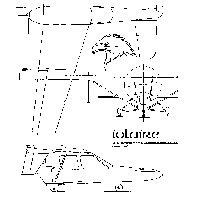|
The initial idea was to drag British
light aviation into the present day by designing an
affordable, safe and easy to handle light aircraft and
to avoid being left even further behind in the design
and manufacturing of light aircraft. So a list of 'must
haves' was drawn up:-
- Reliable, cheap and powerful engine
- All enclosed cockpit
- Wide undercarriage
- Good visibility
- Low running costs
- Ease of handling on the ground as well
as in the air
- Good range
- Crash surviveable
- Stall proof
- Reasonable Vc (cruise velocity)
- Road transportable
- Makeable without specialist tooling
or any specialist skills
|

Figure A - (enlargement) |
To enable this specification to be
incorporated into a single airframe, the tandem canard
layout was chosen using a flat twin BMW motorcycle engine.
To ensure maximum efficiency an 'ALL
FLYING' canard was designed hinging on the 25% chord
line (the aerodynamic centre) and fitted with 'leading
tabs' for self neutralising the pitch and for control
column 'feel'. The aerofoil section used is NACA 0012
i.e. a neutral pitching, symmetrical section. The canard
loading is more than the mainplane so the initial angle
of attack is set at +4°.
The rudders act independently of one
another for yaw control and can be activated at the
same time to act as an airbrake on descent.
The propeller is designed to use torque,
which is plentiful with the BMW engine. This reliable
motor runs at under 3000rpm when the aircraft is at
cruise velocity.
Being a canard the  will not stall. The canard also has a symmetrical section
which itself stalls at 12°, and the mainplane has
a section which stalls at 15°.
will not stall. The canard also has a symmetrical section
which itself stalls at 12°, and the mainplane has
a section which stalls at 15°.
The foam used is EXTRUDED polystyrene
high density insulation board. The awkward parts are
cut using a 'hot wire' system with templates.
The glass gloth is 290t throughout
and the epoxy resin used is West System Epoxy 105/205.
|